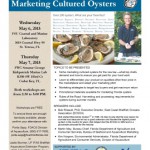
Marketing Cultured Oysters Video Available
The Marketing Cultured Oysters Workshop held at the FSU Coastal and Marine Laboratory on May 6th was videotaped and can now be viewed at the Oyster Culture Topic Page of the website (http://shellfish.ifas.ufl.edu/oyster-culture/). Topics, such as niche marketing, marketing strategies to target key buyers, promotional materials for marketing Florida oysters, and harvesting and processing requirements for oysters during the summer months were presented by Robert Rheault, Executive Director of the East Coast Shellfish Growers Association; Martin May, Department of Agriculture and Consumer Services (DACS), Bureau of Seafood and Aquaculture Marketing; and, Kim Norgren, DACS Division of Aquaculture.










